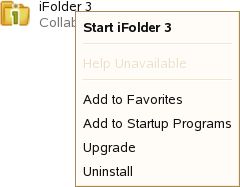6.2 Starting the iFolder Client
When iFolder is running, the  icon appears in the notification area of the taskbar. iFolder is integrated in the desktop environment. The iFolder emblem (a green “i”)
icon appears in the notification area of the taskbar. iFolder is integrated in the desktop environment. The iFolder emblem (a green “i”)  appears on iFolders when they are viewed in a file manager, on the desktop, or in the iFolder browser.The encrypted iFolder is indicated by the
appears on iFolders when they are viewed in a file manager, on the desktop, or in the iFolder browser.The encrypted iFolder is indicated by the  emblem (locked folder).
emblem (locked folder).
IMPORTANT:The notification area of the taskbar must be enabled in order for the icon to be displayed when iFolder is running.
You can work locally with files in your local iFolders at any time. Whenever the iFolder client is running, it logs the changes you make to local iFolder data as you work. If you make changes to local iFolder data when iFolder is not running, iFolder identifies and logs the differences the next time you start iFolder.
When iFolder is not running, iFolders appear in the file manager or on the desktop. You can access files in your local copy of an iFolder, but you cannot manage iFolders. In addition, you must log in to an account to create an iFolder or synchronize its files.
NOTE:During the account creation login happens through SSL. When you are prompted to accept the server certificate, you must validate the certificate and accept it for a successful connection.
For information about stopping the iFolder client, see Section 6.12, Exiting the iFolder Client.
6.2.1 Linux
Starting iFolder Automatically on Login
To enable iFolder to start automatically when you log in to the desktop, do one of the following:
-
Open the applications menu, click , locate and right-click , then select from the menu.

-
Make sure iFolder is running when you log out, then save the session setup. Select this session option when you log in to the desktop.
-
Open a terminal window, log in as the root user, then run /opt/gnome/bin/gnome-session-properties to add iFolder as a program to start when you log in to your computer.
To disable iFolder from starting automatically on login, do one of the following:
-
Open the applications menu, locate and right-click , then select .
-
Make sure iFolder is not running when you log out, then save the session setup. Select this session option when you log in to the desktop.
Starting iFolder Manually
-
Log in to your computer with the local Linux user identity you want to use when you create iFolders.
-
Use one of the following methods to start iFolder:
-
In the taskbar, open the applications menu, click , locate by searching or scrolling through the available options, right-click iFolder 3, then select .
-
Open a terminal shell, then enter
/usr/bin/ifolder
-
6.2.2 Windows
Starting iFolder Automatically on Login
To start iFolder automatically when you log in to the desktop:
-
Right-click the
 icon, then select to open the iFolder Preferences dialog box to the tab.
icon, then select to open the iFolder Preferences dialog box to the tab.
-
Select , then click .
-
Click to close the iFolders Preferences dialog box.
To disable iFolder from starting automatically when you log on to the desktop:
-
Right-click the icon, then select to open the iFolder Preferences dialog box to the tab.
-
Deselect , then click .
-
Click to close the iFolders Preferences dialog box.
Starting iFolder Manually
-
Log in to the computer with the local Windows user identity you want to use when you create iFolders.
-
If iFolder does not start automatically on successful logon, start iFolder by clicking , then select the application.
6.2.3 Macintosh
Starting iFolder Automatically on Login
To enable iFolder to start automatically when you log in to your Macintosh computer, add iFolder to the .
-
Start iFolder.
-
From the dock, right-click the iFolder icon and select the option .
or
From the dock, press the Ctrl key, click the iFolder icon, then select .
To disable iFolder from starting automatically, remove iFolder from the .
-
From the dock, right-click the iFolder icon, and deselect .
or
From the dock, right-click or Ctrl-click the iFolder icon, then deselect
Starting iFolder Manually
-
Log in to your computer with the local Macintosh user identity you want to use when you create iFolders.
-
Use one of the following methods to start iFolder:
-
Open directory on Macintosh HD, select , then double-click .
-
Type iFolder in the spotlight (Apple button + Spacebar or click the magnifying glass icon on top right) then click under Applications.
-
Open a terminal shell, log in as the root user, then enter
/Applications/iFolder 3.app/Contents/MacOS/iFolder 3
-